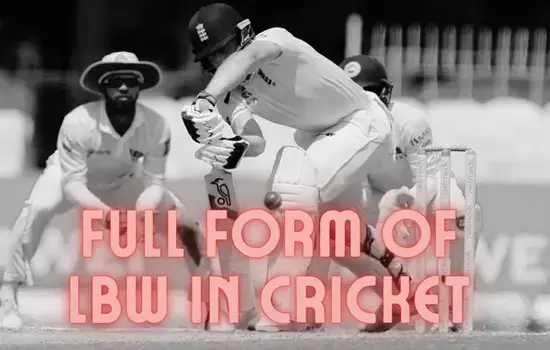In the intricate world of cricket, where every delivery, every shot, and every dismissal tells a story, acronyms and abbreviations pepper the language, often leaving fans and newcomers alike in a state of bewilderment. One such cricketing conundrum is LBW, a term that carries significant weight in the game. In this exploration, we unravel the LBW full form in cricket, deciphering its meaning, its impact on the field, and its role in the chess match between bat and ball.
Full Form of LBW: Leg Before Wicket
LBW stands for “Leg Before Wicket,” a mode of dismissal that adds a layer of complexity to the laws of cricket. This form of dismissal occurs when the batsman is deemed out because the ball, in the opinion of the umpire, strikes any part of the batsman’s leg or body before hitting the bat and would have gone on to hit the stumps.
Understanding the Dynamics of LBW:
- Contact with Leg or Body: The core principle behind LBW is the contact between the ball and any part of the batsman’s leg or body. This includes the leg, hip, or any other part of the body that is not the hand or the glove.
- Path Towards the Stumps: For an LBW decision to be valid, the umpire must believe that, had the leg or body not intervened, the ball would have gone on to hit the stumps. This assessment involves factors such as the trajectory of the ball and its likelihood of hitting the stumps.
LBW in Cricket: A Game-Changing Decision:
- Strategic Role: LBW is not just a statistical entry in the scorebook; it is a strategic move in the battle between batsman and bowler. Bowlers often employ specific tactics to induce an LBW decision, aiming to exploit any vulnerability in a batsman’s technique.
- Technology’s Influence: The introduction of technology, particularly the Decision Review System (DRS), has added a layer of precision to LBW decisions. The use of ball-tracking technology allows for a more accurate assessment of whether the ball would have hit the stumps, reducing controversies and enhancing the integrity of the decision-making process.
Key Factors in LBW Decisions:
- Impact Outside Off-Stump: If the ball strikes the batsman’s leg or body outside the line of the off-stump, the batsman is usually not given out LBW. This provision acknowledges that the batsman should have the freedom to play shots without the constant threat of LBW for deliveries wide of the stumps.
- Umpire’s Judgment: LBW decisions rely heavily on the judgment of the on-field umpire. The umpire must consider the position of the ball, the line it takes, and its potential trajectory had it not made contact with the batsman’s leg or body.
LBW in Cricket Full Form: A Crucial Keyword Revealed:
As we navigate the rich lexicon of cricket, the LBW full form, “Leg Before Wicket,” emerges as a crucial keyword. Beyond its literal meaning, LBW encapsulates the essence of a decision that can sway the momentum of a match, elevate a bowler’s impact, or leave a batsman contemplating the fine line between attack and defense.
Conclusion:
In the dance between bat and ball on the cricket field, LBW, or Leg Before Wicket, stands as a testament to the intricate laws governing the game. It adds a layer of drama, strategy, and anticipation, making every appeal and decision a crucial moment in the unfolding narrative of a cricket match. As the game continues to evolve, the LBW full form remains an integral part of the cricketing lexicon, a symbol of the nuanced battles that define this timeless sport.

Hello, I’m Kapil Kumar, a seasoned SEO expert and blogger at WinnersList.in. My mission is to spotlight exceptional individuals and organizations across various domains. Through curated lists, profiles, and inspiring stories, I aim to celebrate outstanding achievements and inspire the next generation of champions. Join me in this journey.




